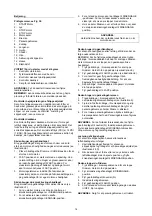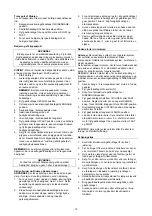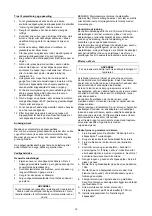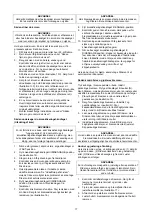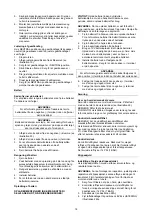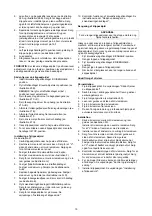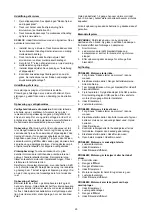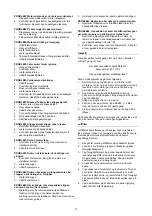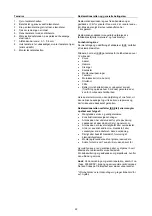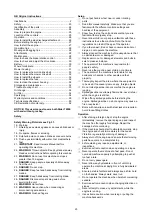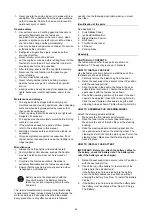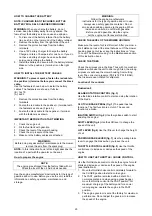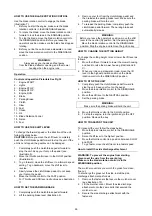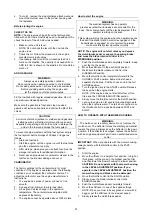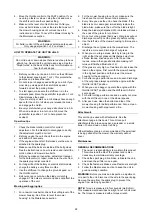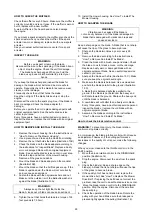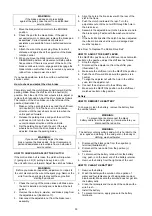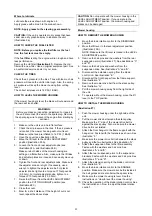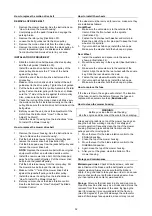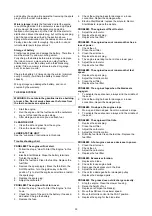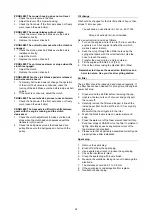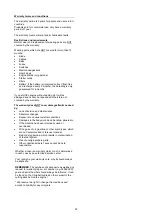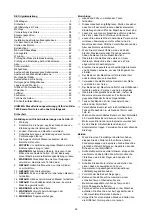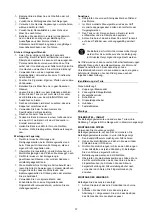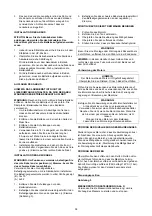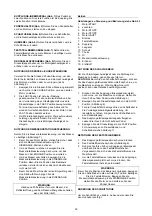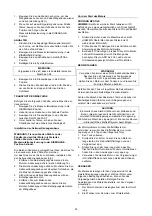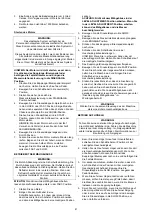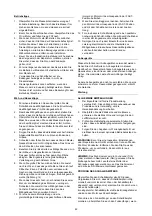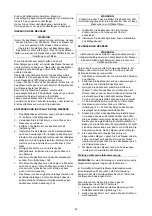
28
8. Move the throttle control to the FAST position. If you
need to go faster or slower, stop the unit and move
the shift lever to another speed setting.
9. Make sure the level of cut is still correct. After you
mow a short distance, look at the area that was cut. If
the mower housing does not cut level, see the
instructions on “How To Level The Mower Housing” in
the Maintenance section.
WARNING:
For better control of the unit, always select a safe speed.
Only use gearposition 1 or 2 on slopes!
HOW TO OPERATE THE UNIT ON HILLS
WARNING:
Do not ride up or down slopes that are too steep to back
straight up. Never ride the unit across a slope. See the
“Slope Guide” in the back of this book for information on
how to check slopes.
1. Before you ride up or down a hill, move the shift lever
to the slowest speed (gear 1 or 2). This protects the
gearbox and reduces the load.
2. Do not stop or change speed settings on a hill. If you
must stop, quickly push the clutch/brake pedal
forward and set the parking brake.
3. To start again, make sure the shift lever is in the
slowest speed. Move the gearshifter to position 1 or 2.
Slowly release the pedal.
4. If you must stop or start on a hill, always have enough
space for the unit to roll when you release the brake
and engage the clutch.
5. Be very careful when you change directions on a hill.
When on a slope or in a turn on a hill, move the
gearshifter to position 1 or 2 to help prevent an
accident.
Operation tips
1. Check the blade rotation control for correct
adjustment. For the blade(s) to disengage correctly,
the adjustment must be correct.
2. Before you use the unit, check the oil in the engine
and add oil if necessary.
3. If the engine will not start, first make sure the wire is
attached to the spark plug.
4. Make sure all the belts are inside all the belt guides.
See the instructions on how to remove and install the
motion drive and mower drive belts.
5. Before you make an inspection, adjustment (except
for the carburetor) or repair, make sure the wire from
the spark plug is disconnected.
6. For longer life of the battery on electric start models,
charge the battery every three months.
7. Use the shift lever to change the ground speed, not
the throttle control.
8. Belt noise can occur when the blade or clutch is
engaged. This noise is normal and does not affect the
operation of the unit.
Mowing and bagging tips
1. For a lawn to look better, check the cutting level of the
mower housing. See “How to level the mower
housing” in the Maintenance section.
2. For the mower housing to cut level, make sure the
tires have the correct amount of air pressure.
3. Every time you use the unit, check the blade. If the
blade is bent or damaged, immediately replace the
blade. Also, make sure the nut for the blade is tight.
4. Keep the blade(s) sharpened. Worn blades will cause
the ends of the grass to turn brown.
5. Do not cut or bag grass that is wet. Wet grass will not
discharge correctly. Let the grass dry before cutting.
6. Use the left side of the mower housing to trim near an
object.
7. Discharge the cut grass onto the mowed area. The
result is a more even discharge of cut grass.
8. When you mow large areas, start by turning to the
right so that the cut grass will discharge away from
shrubs, fences, driveways, etc. After one or two
rounds, mow in the opposite direction making left
turns until finished (Illustration 12).
9. If the grass is very high, cut two times to decrease the
load on the engine. First cut with the mower housing
in the highest position and then lower the mower
housing for the second cut.
10. For better engine performance and an even discharge
of the cut grass, always operate the engine with the
throttle in FAST position.
11. When you use a bagger, operate the engine with the
throttle in FAST position and the shift lever in first or
second gear.
12. For better cutting performance and a quality cut, mow
with the shift lever in one of the slower speeds.
13. After each use, clean the bottom and top of the
mower housing for better performance. Also, a clean
mower housing will help prevent a fire.
Attachments
This unit can be used with attachments. See the
attachment page in this book. This unit can pull
attachments like a lawn sweeper, a spreader or a small
trailer. The max load on trailer is 50 kg.
Other attachments are not recommended. If heavier load
is being pulled after the mower, the warranty will not
cover.
Maintenance
GENERAL RECOMMENDATIONS
1. The owner’s responsibility is to maintain this product.
This will extend the life of the product and is also
necessary to maintain warranty coverage.
2. Check the spark plug, drive brake, lubricate the unit,
and clean the air filter once a year.
3. Check the fasteners. Make sure all fasteners are tight.
4. Follow the Maintenance section to keep the unit in
good operating condition.
WARNING:
Before you make an inspection, adjustment,
or repair to the unit, disconnect the wire to the spark plug.
Remove the wire from the spark plug to prevent the
engine from starting by accident.
NOTE:
Torque is measured in foot pounds (metric Nm).
This measurement describes how tight a nut or bolt must
be. The torque is measured with a torque wrench.
Summary of Contents for 7600E
Page 2: ...2 Illustrationer Illustrations Abbildungen Illustrationer Illustrations Abbildungen 1 2 ...
Page 3: ...3 3 4 ...
Page 4: ...4 5 6 7 8 9 ...
Page 5: ...5 10 11 12 ...
Page 6: ...6 13 A B C 14 15 16 ...
Page 7: ...7 17 18 19 20 21 22 23 24 ...
Page 8: ...8 25 26 ...
Page 9: ...9 27 28 A B C 29 B ...
Page 10: ...10 30 31 32 ...

